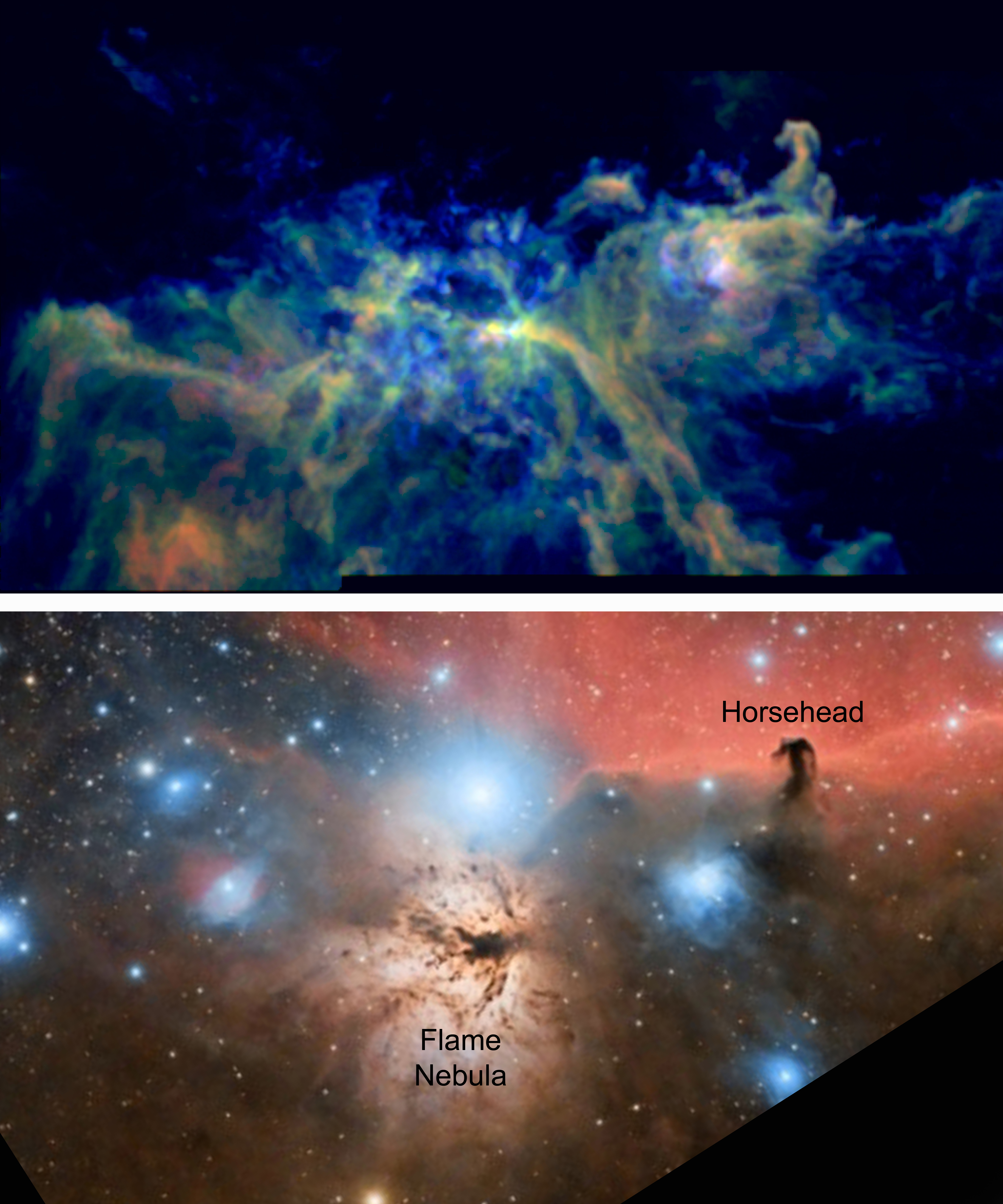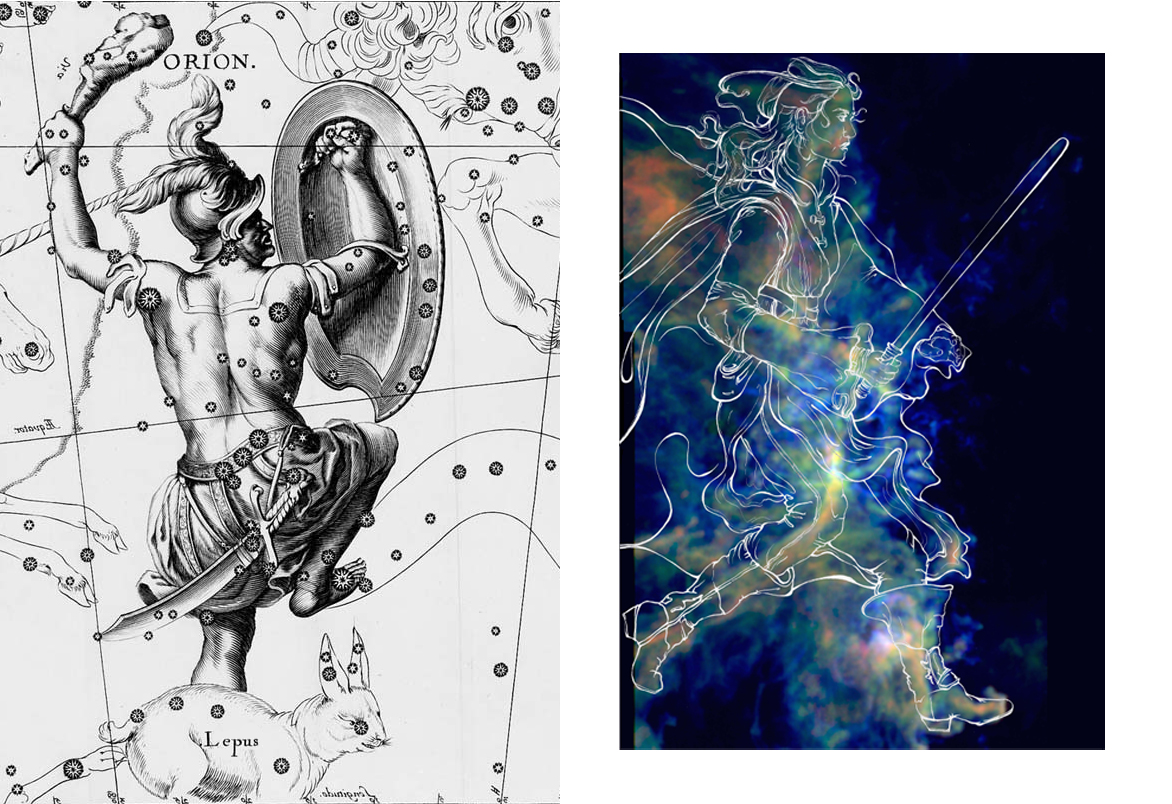News
Beyond the appearances: The anatomy of the Orion Jedi revealed by radio-astronomy
Using the IRAM 30-meter radio-telescope in the Sierra Nevada of Spain, an international team of astronomers led by Jérôme Pety (IRAM & Observatoire de Paris) has obtained the most comprehensive radio-survey of the Orion B star-forming region, famous for hosting the iconic Horsehead and Flame nebulae. Taking advantage of the fact that cold molecules shine at radio millimeter wavelengths, the team revealed the hidden anatomy of the Orion B cloud. Through a careful dissection of the cloud into regions of different molecular composition, they shed new light on how the darkest and coldest inner parts give birth to new stars. Following mankind's tradition of associating characters with features on the sky, the radio astronomy view of Orion B seems to show the skeleton of a fighting Star Wars Jedi!
(The scientific articles will be published in Astronomy & Astrophysics on Tuesday, March 7, 2017.)
 |
| The same region of the Orion B Giant Molecular Cloud seen as a composition of three radio lines observed by the ORION-B Collaboration (top panel: Image credit & copyright J. Pety, the ORION-B Collaboration & IRAM) and in optical (bottom panel: Image credit & copyright Sergi Verdugo Martínez). |
Optical versus radio astronomy
Using the IRAM 30-meter radio-telescope in the Sierra Nevada (Spain), the international ORION-B project has achieved the most comprehensive survey of the Orion B cloud in the radio domain. This region is a huge reservoir of interstellar matter (mostly gaseous molecules and dust grains), containing about 70,000 times the mass of the Sun. Stars are born in condensations that develop in the interior of such interstellar clouds. The strong winds and ultraviolet radiation from newly born stars then erode and disrupt the parental cloud. The breathtaking images obtained by optical telescopes show the interaction of light and matter at the surface of the clouds. However, the potential places of star formation, namely the cold dense cores, only shine at radio millimeter wavelengths. They are invisible for optical telescopes, which is why astronomers use giant radio-telescopes over the world like the IRAM 30-meter telescope.
Jérôme Pety explains: “We have observed the famous Horsehead nebula for more than a decade. However, only the new instrumentation at the IRAM 30-meter telescope has allowed us to map a field of view one hundred times larger than before, and at many millimeter wavelengths simultaneously!” The IRAM 30-meter telescope is able to capture the signals of many molecules in space (carbon monoxide, carbon monosulfide, cyanides, methanol, small hydrocarbons, and the like). As a result, images are obtained that show very different spatial distributions for different molecules: Depending on their chemical evolution, molecules are detected in incredibly different regions of the cloud. This is the key property that allows astronomers to characterize the different steps of star formation. While the diffuse and turbulent phase occupies most of the cloud volume, the dense cores represent only a few percent. In between, the gas is collected through filaments. In Figure 1, the diffuse gas is shown in blue, the dense cores lie inside the pink regions and the filaments are shown in green. Radio images thus are a true dive into the inner anatomy of the Orion B cloud. “Diffuse gas, filaments, and dense cores could be the equivalent of muscles, bones, and vital organs, respectively. And the images of different molecular lines enable to radiography different parts of interstellar clouds, like Magnetic Resonance Imaging (MRI) enables to reveal the interior of the human body” says Viviana Guzman, a post-doctoral fellow at the ALMA observatory in Chile.
But that's not all: The astronomers realized that, funnily enough, some of the radio images of Orion B bear a resemblance with a human skeleton. Sky observations always inspired mankind, as the human mind easily perceives familiar pattern in nature. Jérôme Pety comments: "Orion is a well-known and easily recognizable constellation of the winter sky. It has been interpreted as a hunter in different cultures. When I saw Orion’s radio images for the first time, I visualized a human skeleton holding a light saber. It was as if I was looking at the radiography of a Jedi Knight!" In more than just one way, the images of Orion B delivered new ‘insights’ of the famous nebula.
 |
| The hunter drawn by Johannes Hevelius on the Orion constellation in Prodromus Astronomia, volume III: Firmamentum Sobiescianum, sive Uranographia (1690) and an artistic view of a Jedi knight overlaid on part of the ORION-B project data (Image Credit & Copyright: Audrey Pety). |
Star formation
The new data also shed light on one of the key question of modern astrophysics: Why molecular clouds are so inefficient at forming stars? Gravity should condense the matter of the cloud to form dense cores and stars, however, at most a few percent of the cloud mass is forming stars. What are then the key parameters that control the star formation efficiency? Maryvonne Gerin from CNRS states: "One possibility is the nature of the motions of the gas: compressive motions can trigger the collapse of cores while rotational motions offer an effective resistance to gravitational collapse." In fact, the team quantifies for the first time the fraction of compressive motion that is injected in the Orion B cloud. Jan Orkisz summarizes the results: "The cloud’s motions are on average mostly injected through vortices. This is consistent with the fact that Orion B is the local cloud with the lowest star formation efficiency. Our study shows that, while the overall fraction of compressive motion is low, it increases greatly when zooming into the Flame nebula that is known to host most of the current star formation in Orion B."
The ORION-B observations deliver a huge data set that amounts to more than 160,000 images. Harvey Liszt, astronomer at NRAO, says: “It's flabbergasting to see how this field has grown tremendously. During my PhD, I tuned a precursor millimeter receiver to obtain the first noisy detection of carbon monoxide towards a single direction in Orion B, together with Nobel prize winner Bob Wilson. And a few decades later, we easily get such wide maps for so many molecules over the whole cloud!” No doubt that the future will offer even faster and wider observations for radio astronomers. When that happens, the pioneering statistical approach of the ORION-B project will provide the needed tools and experience to handle bigger and bigger datasets.
Further information
Contacts
Science: Jérôme Pety; Press: Karin Zacher
References
- Doi:10.1051/0004-6361/201629862 Jérôme Pety, Viviana V. Guzmán, Jan H. Orkisz, Harvey S. Liszt, Maryvonne Gerin, Emeric Bron, Sébastien Bardeau, Javier R. Goicoechea, Pierre Gratier, Franck Le Petit, François Levrier, Karin I. Oberg, Evelyne Roueff, Albrecht Sievers. “The anatomy of the Orion B Giant Molecular Cloud: A local template for studies of nearby galaxies”.
- Doi:10.1051/0004-6361/201629847 Pierre Gratier, Emeric Bron, Maryvonne Gerin, Jérôme Pety, Viviana V. Guzman, Jan Orkisz, Sébastien Bardeau, Javier R. Goicoechea, Franck Le Petit, Harvey Liszt, Karin Öberg, Nicolas Peretto, Evelyne Roueff, Albrecht Sievers, Pascal Tremblin. “Dissecting the molecular structure of the Orion B cloud: Insight from Principal Component Analysis”.
- Doi:10.1051/0004-6361/201629220 Jan H. Orkisz, Jérôme Pety, Maryvonne Gerin, Emeric Bron, Viviana V. Guzmán, Sébastien Bardeau, Javier R. Goicoechea, Pierre Gratier, Franck Le Petit, François Levrier, Harvey Liszt, Karin Öberg, Nicolas Peretto, Evelyne Roueff, Albrecht Sievers, Pascal Tremblin. “Turbulence and star formation efficiency in molecular clouds: solenoidal versus compressive motions in Orion B”.
Related research
- Discover the IRAM 30 meter telescope!
- The discovery of a new interstellar molecule confirms the existence of a petroleum refinery in our galaxy
- Zooming into the skin of the Orion hunter
STAR WARS and all related characters, names are registrated trademarks or copyrights of Lucasfilm Ltd., or their respective trademark and copyright holders.



